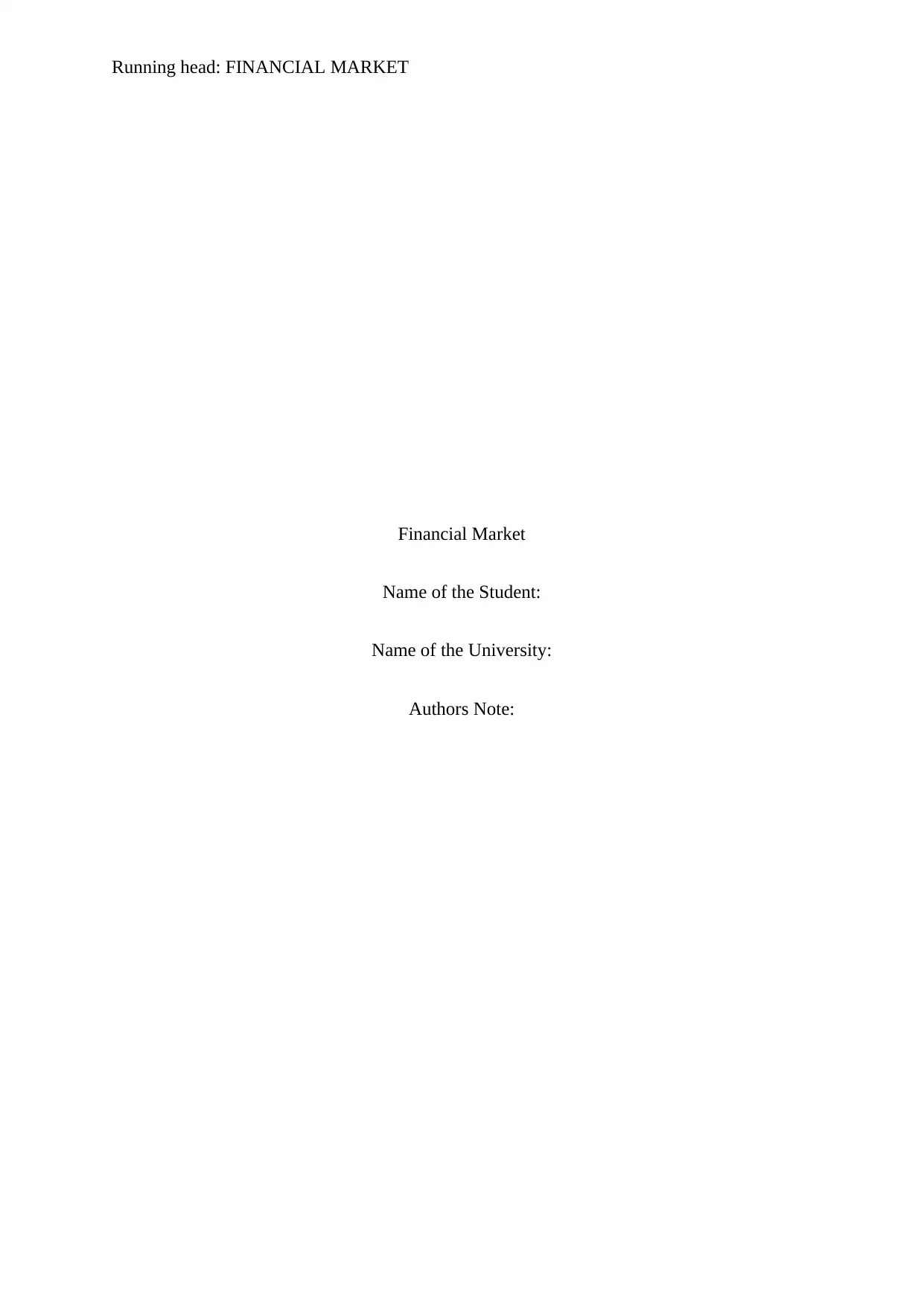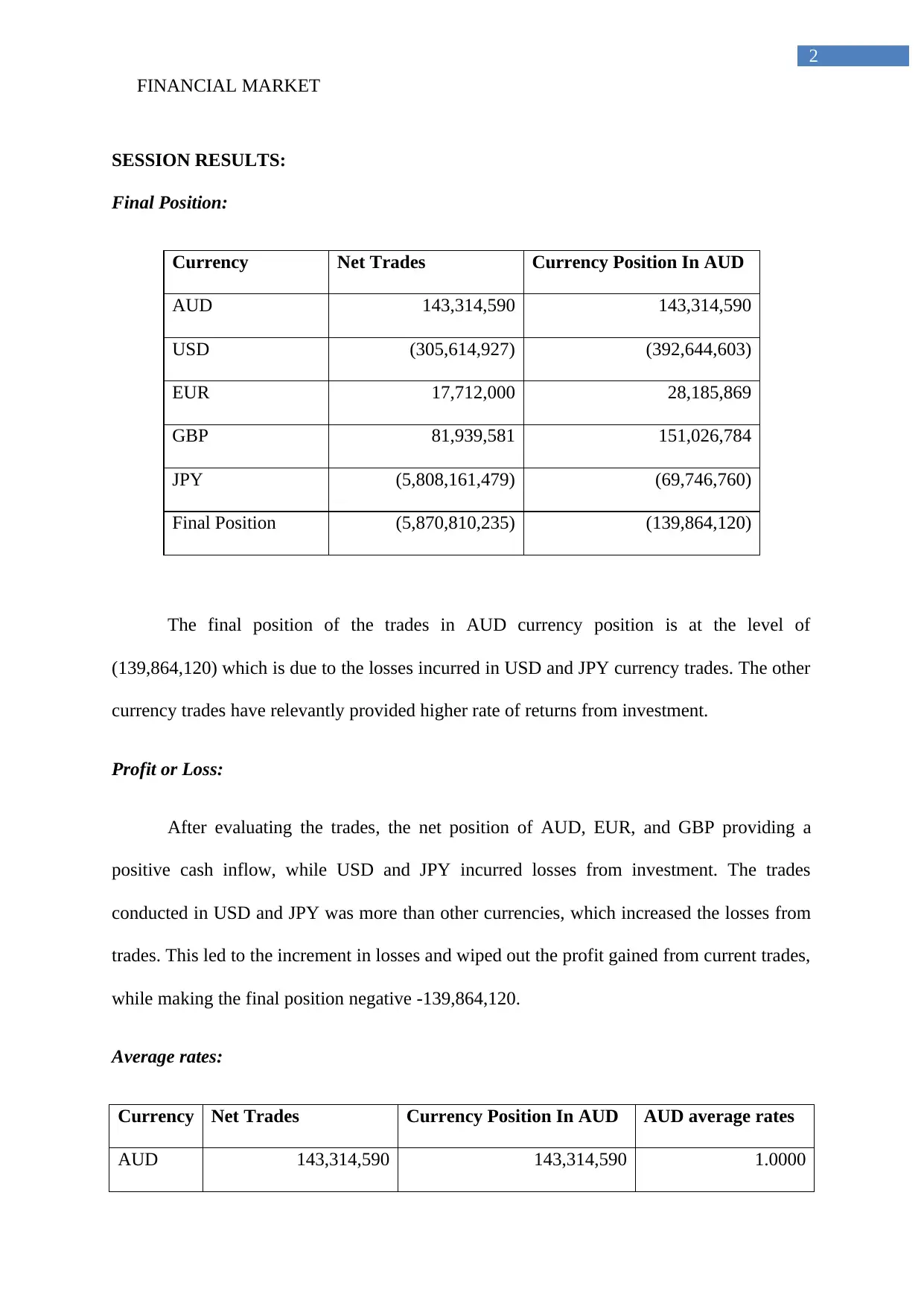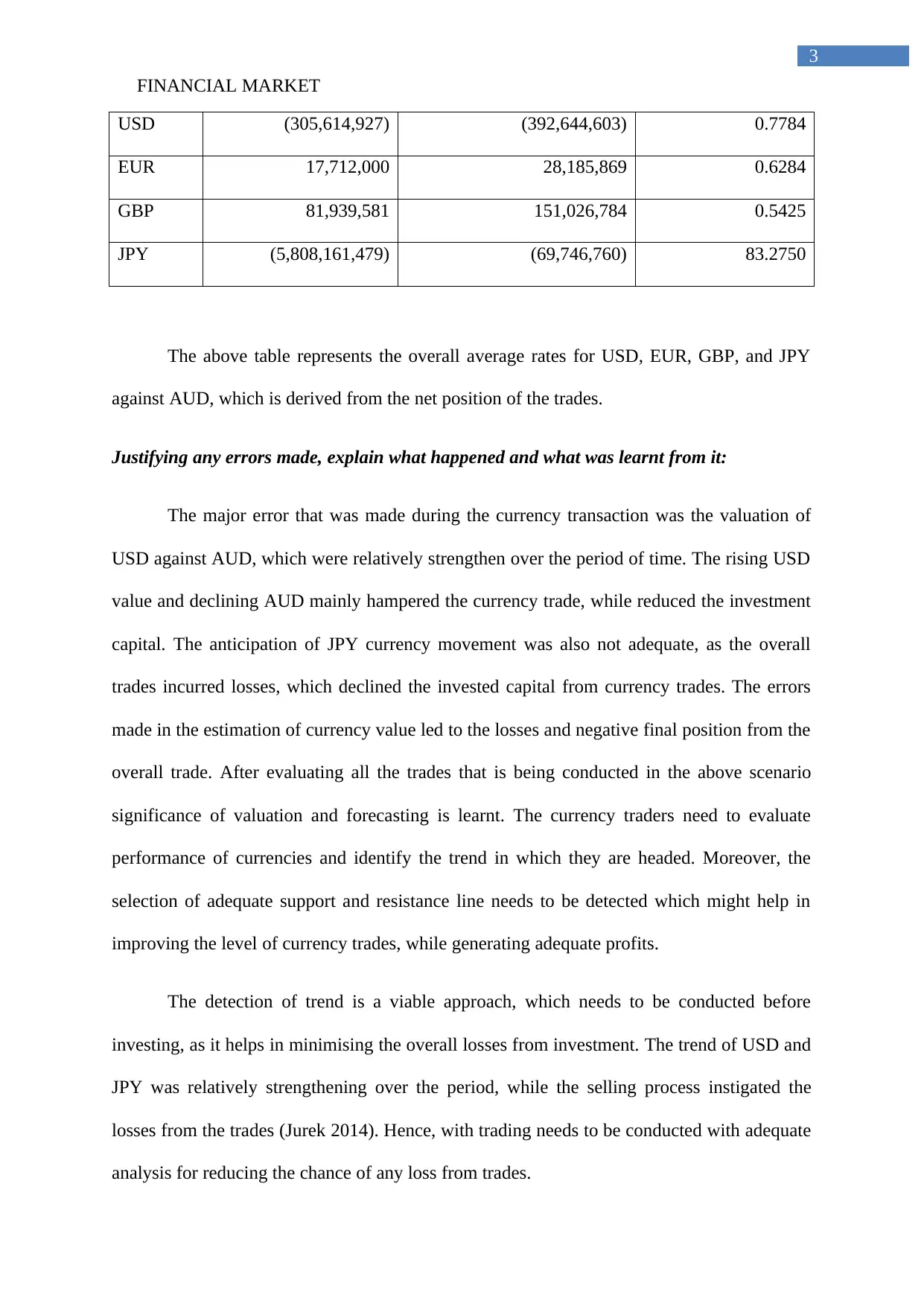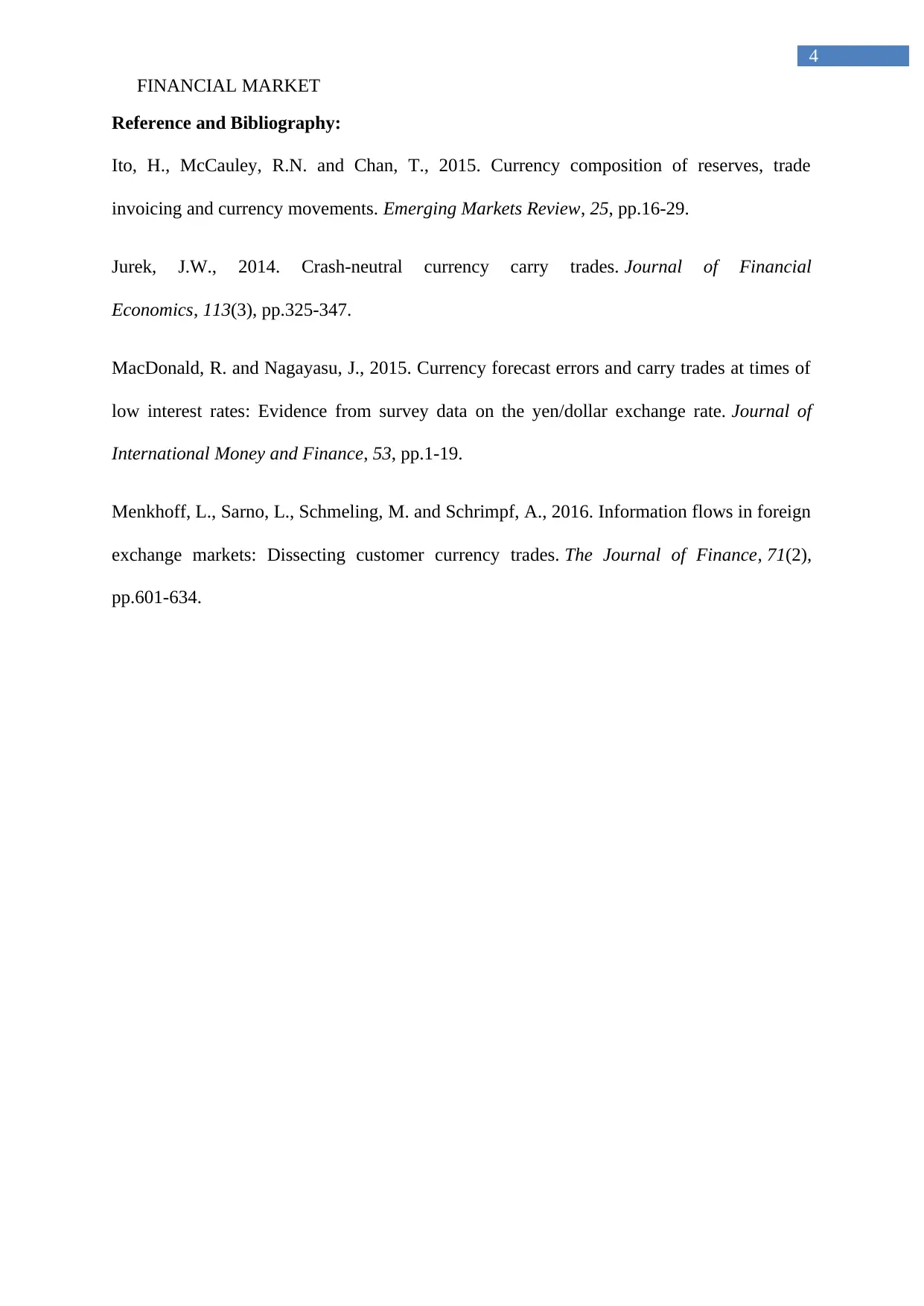ABN AMRO Financial Markets: Detailed Forex Trading Report
VerifiedAdded on 2023/06/12
|5
|692
|172
Report
AI Summary
This report provides a detailed analysis of a forex trading session, focusing on the performance of ABN AMRO in the foreign exchange market. It includes an examination of currency positions in AUD, USD, EUR, GBP, and JPY, highlighting the net trades and their impact on the overall portfolio. The repor...

Running head: FINANCIAL MARKET
Financial Market
Name of the Student:
Name of the University:
Authors Note:
Financial Market
Name of the Student:
Name of the University:
Authors Note:
Paraphrase This Document
Need a fresh take? Get an instant paraphrase of this document with our AI Paraphraser

FINANCIAL MARKET
1
Table of Contents
SESSION RESULTS:................................................................................................................2
Reference and Bibliography:......................................................................................................4
1
Table of Contents
SESSION RESULTS:................................................................................................................2
Reference and Bibliography:......................................................................................................4

FINANCIAL MARKET
2
SESSION RESULTS:
Final Position:
Currency Net Trades Currency Position In AUD
AUD 143,314,590 143,314,590
USD (305,614,927) (392,644,603)
EUR 17,712,000 28,185,869
GBP 81,939,581 151,026,784
JPY (5,808,161,479) (69,746,760)
Final Position (5,870,810,235) (139,864,120)
The final position of the trades in AUD currency position is at the level of
(139,864,120) which is due to the losses incurred in USD and JPY currency trades. The other
currency trades have relevantly provided higher rate of returns from investment.
Profit or Loss:
After evaluating the trades, the net position of AUD, EUR, and GBP providing a
positive cash inflow, while USD and JPY incurred losses from investment. The trades
conducted in USD and JPY was more than other currencies, which increased the losses from
trades. This led to the increment in losses and wiped out the profit gained from current trades,
while making the final position negative -139,864,120.
Average rates:
Currency Net Trades Currency Position In AUD AUD average rates
AUD 143,314,590 143,314,590 1.0000
2
SESSION RESULTS:
Final Position:
Currency Net Trades Currency Position In AUD
AUD 143,314,590 143,314,590
USD (305,614,927) (392,644,603)
EUR 17,712,000 28,185,869
GBP 81,939,581 151,026,784
JPY (5,808,161,479) (69,746,760)
Final Position (5,870,810,235) (139,864,120)
The final position of the trades in AUD currency position is at the level of
(139,864,120) which is due to the losses incurred in USD and JPY currency trades. The other
currency trades have relevantly provided higher rate of returns from investment.
Profit or Loss:
After evaluating the trades, the net position of AUD, EUR, and GBP providing a
positive cash inflow, while USD and JPY incurred losses from investment. The trades
conducted in USD and JPY was more than other currencies, which increased the losses from
trades. This led to the increment in losses and wiped out the profit gained from current trades,
while making the final position negative -139,864,120.
Average rates:
Currency Net Trades Currency Position In AUD AUD average rates
AUD 143,314,590 143,314,590 1.0000
⊘ This is a preview!⊘
Do you want full access?
Subscribe today to unlock all pages.

Trusted by 1+ million students worldwide

FINANCIAL MARKET
3
USD (305,614,927) (392,644,603) 0.7784
EUR 17,712,000 28,185,869 0.6284
GBP 81,939,581 151,026,784 0.5425
JPY (5,808,161,479) (69,746,760) 83.2750
The above table represents the overall average rates for USD, EUR, GBP, and JPY
against AUD, which is derived from the net position of the trades.
Justifying any errors made, explain what happened and what was learnt from it:
The major error that was made during the currency transaction was the valuation of
USD against AUD, which were relatively strengthen over the period of time. The rising USD
value and declining AUD mainly hampered the currency trade, while reduced the investment
capital. The anticipation of JPY currency movement was also not adequate, as the overall
trades incurred losses, which declined the invested capital from currency trades. The errors
made in the estimation of currency value led to the losses and negative final position from the
overall trade. After evaluating all the trades that is being conducted in the above scenario
significance of valuation and forecasting is learnt. The currency traders need to evaluate
performance of currencies and identify the trend in which they are headed. Moreover, the
selection of adequate support and resistance line needs to be detected which might help in
improving the level of currency trades, while generating adequate profits.
The detection of trend is a viable approach, which needs to be conducted before
investing, as it helps in minimising the overall losses from investment. The trend of USD and
JPY was relatively strengthening over the period, while the selling process instigated the
losses from the trades (Jurek 2014). Hence, with trading needs to be conducted with adequate
analysis for reducing the chance of any loss from trades.
3
USD (305,614,927) (392,644,603) 0.7784
EUR 17,712,000 28,185,869 0.6284
GBP 81,939,581 151,026,784 0.5425
JPY (5,808,161,479) (69,746,760) 83.2750
The above table represents the overall average rates for USD, EUR, GBP, and JPY
against AUD, which is derived from the net position of the trades.
Justifying any errors made, explain what happened and what was learnt from it:
The major error that was made during the currency transaction was the valuation of
USD against AUD, which were relatively strengthen over the period of time. The rising USD
value and declining AUD mainly hampered the currency trade, while reduced the investment
capital. The anticipation of JPY currency movement was also not adequate, as the overall
trades incurred losses, which declined the invested capital from currency trades. The errors
made in the estimation of currency value led to the losses and negative final position from the
overall trade. After evaluating all the trades that is being conducted in the above scenario
significance of valuation and forecasting is learnt. The currency traders need to evaluate
performance of currencies and identify the trend in which they are headed. Moreover, the
selection of adequate support and resistance line needs to be detected which might help in
improving the level of currency trades, while generating adequate profits.
The detection of trend is a viable approach, which needs to be conducted before
investing, as it helps in minimising the overall losses from investment. The trend of USD and
JPY was relatively strengthening over the period, while the selling process instigated the
losses from the trades (Jurek 2014). Hence, with trading needs to be conducted with adequate
analysis for reducing the chance of any loss from trades.
Paraphrase This Document
Need a fresh take? Get an instant paraphrase of this document with our AI Paraphraser

FINANCIAL MARKET
4
Reference and Bibliography:
Ito, H., McCauley, R.N. and Chan, T., 2015. Currency composition of reserves, trade
invoicing and currency movements. Emerging Markets Review, 25, pp.16-29.
Jurek, J.W., 2014. Crash-neutral currency carry trades. Journal of Financial
Economics, 113(3), pp.325-347.
MacDonald, R. and Nagayasu, J., 2015. Currency forecast errors and carry trades at times of
low interest rates: Evidence from survey data on the yen/dollar exchange rate. Journal of
International Money and Finance, 53, pp.1-19.
Menkhoff, L., Sarno, L., Schmeling, M. and Schrimpf, A., 2016. Information flows in foreign
exchange markets: Dissecting customer currency trades. The Journal of Finance, 71(2),
pp.601-634.
4
Reference and Bibliography:
Ito, H., McCauley, R.N. and Chan, T., 2015. Currency composition of reserves, trade
invoicing and currency movements. Emerging Markets Review, 25, pp.16-29.
Jurek, J.W., 2014. Crash-neutral currency carry trades. Journal of Financial
Economics, 113(3), pp.325-347.
MacDonald, R. and Nagayasu, J., 2015. Currency forecast errors and carry trades at times of
low interest rates: Evidence from survey data on the yen/dollar exchange rate. Journal of
International Money and Finance, 53, pp.1-19.
Menkhoff, L., Sarno, L., Schmeling, M. and Schrimpf, A., 2016. Information flows in foreign
exchange markets: Dissecting customer currency trades. The Journal of Finance, 71(2),
pp.601-634.
1 out of 5
Related Documents
Your All-in-One AI-Powered Toolkit for Academic Success.
+13062052269
info@desklib.com
Available 24*7 on WhatsApp / Email
![[object Object]](/_next/static/media/star-bottom.7253800d.svg)
Unlock your academic potential
© 2024 | Zucol Services PVT LTD | All rights reserved.



